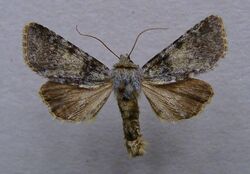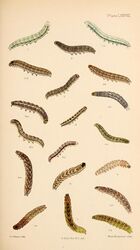Biology:Hadena caesia
| Hadena caesia | |
|---|---|

| |
| Scientific classification | |
| Domain: | Eukaryota |
| Kingdom: | Animalia |
| Phylum: | Arthropoda |
| Class: | Insecta |
| Order: | Lepidoptera |
| Superfamily: | Noctuoidea |
| Family: | Noctuidae |
| Genus: | Hadena |
| Species: | H. caesia
|
| Binomial name | |
| Hadena caesia (Denis & Schiffermüller, 1775)
| |
| Synonyms | |
| |
Hadena caesia, also called the grey, is a species of moth of the family Noctuidae. It has a scattered distribution all over Europe (see subspecies section).
Technical description and variation
The wingspan is 32–37 millimetres (1.3–1.5 in). Forewing blue grey, with a furry look, caused by dusky grey irroration; both folds tinged with fulvous; lines and markings often indistinct; upper stigmata pale, with yellow scales in their annuli; a dark antemedian band widened to inner margin and a less prominent dark submarginal cloud; a small dark blotch at middle of costa; hindwing dark fuscous, paler towards base; — manani Gregs. from the Isle of Man and the Irish coast, is uniformly darker slate colour; — ab. nigrescens Stgr., from the Pyrenees, Alps, and Mts. of Scandinavia is much darker, the forewing suffused with black; on the other hand [now full species Hadena clara] Stgr., from Armenia and Asia Minor, has the forewing greyer, with a pinkish tinge; the median area paler.[1]
Biology
Adults are on wing from June to August.[2]
Larva brownish ochreous, freckled with darker; a dorsal series of V-shaped marks; subdorsal line darker. The young larvae feed on capsules of various Silene species (including Silene nutans and Silene vulgaris).[3] Later, they feed on the leaves. They overwinter as a pupa.
Subspecies
- ssp. caesia (Denis&Schiffermüller, 1775) (Alps)
- ssp. abruzzensis (Draudt, 1934) (Apennine Mountains)
- ssp. ostrogovichi (Hacker, 1989) (Carpathian Mountains)
- ssp. bulgarica (Boursin, 1959) (Bulgaria)
- ssp. xanthophoba (Schawerda, 1922) (Balkan Peninsula)
- ssp. mananii (Gregson, 1866) (Great Britain and Ireland)
- ssp. frigida (Zetterstedt, 1839) (southern Fennoscandia)
- ssp. grisea (Hospital, 1948) (mountains of northern Spain )
- ssp. revolcadorensis (Calle, 1983) (the Region of Murcia)
- ssp. castiliana (Reisser, 1935) (Castile region)
References
- ↑ Seitz, A. Ed., 1914 Die Großschmetterlinge der Erde, Verlag Alfred Kernen, Stuttgart Band 3: Abt. 1, Die Großschmetterlinge des palaearktischen Faunengebietes, Die palaearktischen eulenartigen Nachtfalter, 1914
- ↑ Richard South (1907). "The Moths of the British Isles". Frederick Warne & Co. (Wikisource). http://en.wikisource.org/wiki/The_Moths_of_the_British_Isles/Chapter_15#290. Retrieved 6 January 2013.
- ↑ "Robinson, G. S., P. R. Ackery, I. J. Kitching, G. W. Beccaloni & L. M. Hernández, 2010. HOSTS - A Database of the World's Lepidopteran Hostplants. Natural History Museum, London.". http://www.nhm.ac.uk/research-curation/research/projects/hostplants/.
External links
Wikidata ☰ Q310185 entry
 |


